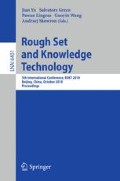Abstract
Our research is devoted to develop a new method of generation of a set of decision rules. This method is compiled using two different mechanisms. The first one is based on applying a new constructive induction algorithm to the investigated dataset. The belief networks are used in this algorithm. The aim is to find the most important descriptive attribute that is calculated on the basis of other attributes. The second part of the presented method constitutes the improvement algorithm that is used in an optimization process of a gathered rule set. The results of our research contain the comparison of classification efficiency using several datasets.
Access this chapter
Tax calculation will be finalised at checkout
Purchases are for personal use only
Preview
Unable to display preview. Download preview PDF.
References
Fayyad, U., Piatetsky-Shapiro, G., Smyth, P.: From data mining to knowledge discovery in databases. AI Magazine 17, 37–54 (1996)
Piramuthu, S., Sikora, R.: Iterative feature construction for improving inductive learning algorithms. Expert Systems with Application 36, 3401–3406 (2009)
Liu, H., Sun, J., Zhang, H.: Post-processing of associative classification rules using closed sets. Expert Systems with Application 36, 6659–6667 (2009)
Spreeuwenberg, S., Gerrits, R.: Requirements for successful verification in practice. In: Haller, S., Simmons, G. (eds.) Proc. of the 15th International Florida Artificial Intelligence Research Society Conference, Pensacola Beach, Florida, USA (2002)
Jensen, F.: Logical Foundations for Rule-Based Systems. Springer, Heidelberg (2006)
Lo, D., Khoo, S., Wong, L.: Non-redundant sequential rules – theory and algorithm. Information Systems 34(4-5), 438–453 (2009)
Gonzales, A., Barr, V.: Validation and verification of intelligent systems. Journal of Experimental & Theoretical Artificial Intelligence 12(2), 407–420 (2000)
Wnek, J., Michalski, R.: Hypothesis-driven constructive induction in AQ17-HCI: A method and experiments. Machine Learning 14(2), 139–168 (1994)
Friedman, R., Rigel, D., Kopf, A.: Early detection of malignant melanoma: the role of physician examination and self-examination of the skin. CA: A Cancer Journal for Clinicians 35, 130–151 (1985)
Hippe, Z., Bajcar, S., Blajdo, P., Grzymala-Busse, J., Grzymala-Busse, J., Knap, M., Paja, W., Wrzesien, M.: Diagnosing skin melanoma: Current versus future directions. TASK Quarterly 7(2), 289–293 (2003)
Duch, W., Kucharski, T., Gomuła, J., Adamczak, R.: Machine learning methods in analysis of psychometric data. Application to Multiphasic Personality Inventory MMPI-WISKAD, Toruń (1999) (in polish)
Hippe, Z.: Machine learning – a promising strategy for business information systems? In: Abramowicz, W. (ed.) Business Information Systems 1997, pp. 603–622. Academy of Economics, Poznan (1997)
Jensen, F.: Bayesian Networks and Decision Graphs. Springer, Heidelberg (2001)
Błajdo, P., Grzymała-Busse, J., Hippe, Z., Knap, M., Marek, T., Mroczek, T., Wrzesień, M.: A suite of machine learning programs for data mining: chemical applications. In: Debska, B., Fic, G. (eds.) Information Systems in Chemistry, vol. 2, pp. 7–14. University of Technology Editorial Office, Rzeszow (2004)
Paja, W.: RuleSEEKER – a new system to manage knowledge in form of decision rules. In: Tadeusiewicz, R., Ligeza, A., Szymkat, M. (eds.) Computer Methods and Systems. Ed. Office ONT, Cracow, pp. 367–370 (1997) (in polish)
Author information
Authors and Affiliations
Editor information
Editors and Affiliations
Rights and permissions
Copyright information
© 2010 Springer-Verlag Berlin Heidelberg
About this paper
Cite this paper
Paja, W., Pancerz, K., Wrzesień, M. (2010). A New Hybrid Method of Generation of Decision Rules Using the Constructive Induction Mechanism. In: Yu, J., Greco, S., Lingras, P., Wang, G., Skowron, A. (eds) Rough Set and Knowledge Technology. RSKT 2010. Lecture Notes in Computer Science(), vol 6401. Springer, Berlin, Heidelberg. https://doi.org/10.1007/978-3-642-16248-0_47
Download citation
DOI: https://doi.org/10.1007/978-3-642-16248-0_47
Publisher Name: Springer, Berlin, Heidelberg
Print ISBN: 978-3-642-16247-3
Online ISBN: 978-3-642-16248-0
eBook Packages: Computer ScienceComputer Science (R0)

